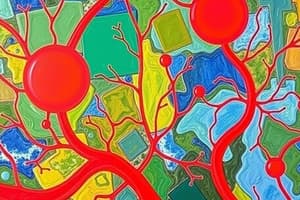Podcast
Questions and Answers
Which of the following plant adaptations is most directly responsible for the movement of water from roots to leaves?
Which of the following plant adaptations is most directly responsible for the movement of water from roots to leaves?
- Sieve plates
- Lignin (correct)
- Bordered pits
- Mitochondria in companion cells
How does the large surface area to volume ratio of single-celled organisms benefit them?
How does the large surface area to volume ratio of single-celled organisms benefit them?
- It reduces their susceptibility to predation.
- It enables them to absorb water more rapidly.
- It allows for more efficient diffusion of nutrients and waste products. (correct)
- It allows them to produce more energy through respiration.
Which two of the following statements accurately describe transpiration?
Which two of the following statements accurately describe transpiration?
- Transpiration is the process of transporting sugars from leaves to other parts of the plant.
- Transpiration is the movement of water from the roots to the leaves.
- Transpiration is driven by the evaporation of water from the plant's surface. (correct)
- Transpiration is a passive process that does not require energy. (correct)
What is the main function of sieve plates in phloem?
What is the main function of sieve plates in phloem?
What is the primary factor that drives the movement of water through the xylem?
What is the primary factor that drives the movement of water through the xylem?
Which of the following factors would NOT affect the rate of transpiration?
Which of the following factors would NOT affect the rate of transpiration?
What is the primary function of root hair cells in plants?
What is the primary function of root hair cells in plants?
How does the movement of substances in phloem differ from the movement of substances in xylem?
How does the movement of substances in phloem differ from the movement of substances in xylem?
Which of the following is NOT a characteristic of xylem tissue?
Which of the following is NOT a characteristic of xylem tissue?
Why is the surface area to volume ratio important for efficient transport of substances within organisms?
Why is the surface area to volume ratio important for efficient transport of substances within organisms?
Flashcards
Diffusion
Diffusion
A passive process where particles move from high to low concentration.
Translocation
Translocation
Transporting sugars and amino acids within a plant.
Xylem
Xylem
Vascular tissue that carries water from roots to leaves.
Lignin
Lignin
Signup and view all the flashcards
Transpiration
Transpiration
Signup and view all the flashcards
Root Hair Cells
Root Hair Cells
Signup and view all the flashcards
Companion Cells
Companion Cells
Signup and view all the flashcards
Hydrogen Bonding
Hydrogen Bonding
Signup and view all the flashcards
Factors Affecting Transpiration
Factors Affecting Transpiration
Signup and view all the flashcards
Sieve Plates
Sieve Plates
Signup and view all the flashcards
Study Notes
Transport in Organisms
- Diffusion is the passive movement of particles from an area of high concentration to an area of low concentration.
- Single-celled organisms rely on diffusion to transport molecules because their surface area-to-volume ratio is large enough.
- Multicellular organisms have a smaller surface area-to-volume ratio. Therefore, they use specialized transport systems.
- Examples of specialized transport systems in multicellular organisms include alveoli in the lungs, villi in the small intestines, and root hair cells in plants.
Transport in Plants
Phloem Adaptations
- Phloem transports sucrose and amino acids between leaves and other plant parts (translocation).
- Phloem cells are located in roots, stems, and leaves.
- Phloem cells are elongated with perforated end walls called sieve plates, facilitating the movement of substances.
- Companion cells in the phloem provide energy to transport sugars.
- Translocation can occur in both directions, carrying sugars from sources (where they are made) to sinks (where they are needed).
Xylem Adaptations
- Xylem transports water and mineral ions from the roots to the leaves (water transport).
- Xylem cells are dead, hollow, and strengthened by lignin to support and transport water.
- Lignin deposition causes cells to die, allowing them to form continuous tubes.
- These tubes enable the movement of water from the roots to the leaves.
- Water molecules adhere to each other through hydrogen bonding, creating a continuous water column.
- Water evaporates from the leaves, creating a transpiration stream to pull more water up the plant.
- Bordered pits in the lignin allow water and minerals to pass into the xylem.
Water Absorption
- Water is absorbed from the soil by root hair cells.
- Root hair cells have a large surface area for efficient water absorption through osmosis.
- Increased transpiration rate increases water uptake rate to replace the lost water.
Transpiration and Water Uptake
- Transpiration is the evaporation of water from the surface of a plant.
- Stomata are openings on leaves that allow gases to enter and leave.
- Water evaporates through the open stomata.
- Water molecules' attraction to each other creates a pull that draws water up the plant.
- Water is drawn up from the soil, creating a transpiration stream.
Factors Affecting Transpiration
- Increase in light intensity: More stomata open to allow gaseous exchange for photosynthesis. This leads to increased water evaporation, hence increased transpiration rate.
- Increase in temperature: Higher temperatures result in faster-moving water molecules, increased evaporation, and thus increased transpiration rate.
Studying That Suits You
Use AI to generate personalized quizzes and flashcards to suit your learning preferences.




